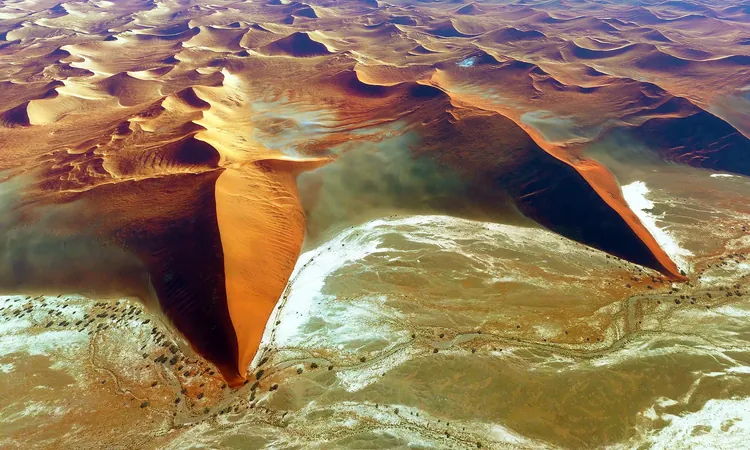
Unveiling the Mysteries of Star Dunes: Nature's Geometric Marvels Across the Deserts
2025-03-29
Author: Jessica Wong
Introduction
Sand dunes are not just formations of sand; they are mesmerizing spectacles that sculpt the landscape of arid regions around the globe. Among these, star dunes—often referred to as pyramid dunes—are particularly striking with their towering heights and unique star-like designs.
The Emergence of Star Dunes
Star dunes thrive in sand seas found in diverse areas including Africa, Arabia, China, and North America. They emerge in environments where winds blow from multiple directions and where sand accumulates significantly. This creates a towering, pyramid-like center with several arms radiating outward, giving them their characteristic star shape when observed from above.
The Tallest Star Dune and Geographic Wonders
Some of these dunes boast impressive heights. A notable example resides in the Badain Jaran Desert of China, where a star dune reaches approximately 984 feet tall, comparable to the height of Paris's iconic Eiffel Tower.
Star Dunes on Earth and Beyond
While star dunes are plentiful in contemporary deserts and even observed on extraterrestrial bodies like Mars and Titan, Saturn's moon, their presence in the geological record has remained elusive. Researchers have long debated why these formations leave little evidence in ancient sandstone layers.
Research Initiatives and Discoveries
Leading this research effort is Professor Geoff Duller from Aberystwyth University, who, alongside colleagues from Birkbeck and University College London, has made significant strides in unraveling the mysteries surrounding these colossal formations. Their latest investigation focuses on a star dune in Morocco, offering new insights into its internal structure and formation speed.
The Discovery of Lala Lallia
The Erg Chebbi region of southeastern Morocco has revealed a remarkable star dune known as Lala Lallia, translating to "highest sacred point" in Berber. This dune stands about 328 feet tall and spans approximately 2,297 feet at its base. Interestingly, the oldest layers of Lala Lallia were formed roughly 13,000 years ago, coinciding with the Younger Dryas, a significant climatic cooling event.
The findings indicate that for about 8,000 years, the dune remained relatively inactive until a shift towards drier climatic conditions allowed for sand accumulation at an accelerated rate. Recent studies show that this majestic dune has grown considerably, particularly in the last millennium, and is currently advancing approximately 1.6 feet annually.
Technological Breakthroughs in Research
Innovative techniques, such as ground-penetrating radar and optically stimulated luminescence (OSL) dating, have allowed researchers to peer into the internal structures of star dunes. These methods have shed light on their rapid formation periods and have offered new interpretations of geological records, providing clues about ancient environmental conditions.
Professor Charlie Bristow from Birkbeck and UCL remarked, "Using ground-penetrating radar has allowed us to develop models for geologists to identify these remarkable desert formations in older rock records."
Impact on Understanding Ancient Climates
This groundbreaking research changes the narrative regarding the geological absence of star dunes. Their internal structure can mimic that of other dune types, making them difficult to detect in solidified rock. The insights gained from the Moroccan study not only enhance geological understanding but potentially influence studies on ancient wind patterns, water resources, and carbon storage.
As changing climatic conditions continue to reshape our planet, recognizing star dunes and their wonderful structures may provide vital information about past environments, assisting in current and future efforts to manage desert ecosystems.
Looking Ahead: The Significance of Star Dunes
Overall, star dunes represent significant natural phenomena that hold keys to understanding Earth's climatic history. The tools developed from research conducted in barren landscapes provide scientists with improved methods for uncovering hidden geological stories, leading to a greater comprehension of our planet's dynamic history.
Conclusion
Engage with the wonders of nature! Stay updated with our latest discoveries and insights into the natural world.

 Brasil (PT)
Brasil (PT)
 Canada (EN)
Canada (EN)
 Chile (ES)
Chile (ES)
 Česko (CS)
Česko (CS)
 대한민국 (KO)
대한민국 (KO)
 España (ES)
España (ES)
 France (FR)
France (FR)
 Hong Kong (EN)
Hong Kong (EN)
 Italia (IT)
Italia (IT)
 日本 (JA)
日本 (JA)
 Magyarország (HU)
Magyarország (HU)
 Norge (NO)
Norge (NO)
 Polska (PL)
Polska (PL)
 Schweiz (DE)
Schweiz (DE)
 Singapore (EN)
Singapore (EN)
 Sverige (SV)
Sverige (SV)
 Suomi (FI)
Suomi (FI)
 Türkiye (TR)
Türkiye (TR)
 الإمارات العربية المتحدة (AR)
الإمارات العربية المتحدة (AR)